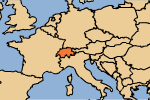url: http://edufile.info/index.php?view=school_systems&topic=topic_general_infos&country=10
School systems Switzerland
| Kindergartens | Primary schools | Secondary schools | Higher education
Country


Switzerland (Swiss Confederation) is a country in the Western Europe. The country covers an area of 41,285 km² and its populations compromises of 7.59 million people. The official languages are German, French, Italian and Romansh.
Overview
 The school systems in respective cantos are quite autonomous, apart from the quality controls and the guarantee of education.
The school systems in respective cantos are quite autonomous, apart from the quality controls and the guarantee of education.
There are 10742 (90%) public schools and 1176 (10%) private schools (all levels of education).
Education is compulsory from the age of 5 (kindergarten) for 11 years. It's free of charge. There are no nationwide tests. Home schooling is possible, but with special application.
Kindergartens
Last years of kindergartens are compulsory (age 5). There are round 5 thousands kindergartens of which 5% are private. It's possible to leave the kindergarten before the end if a child seems to be ready for entering primary school.
Primary schools
There are round six thousand primary schools, of which 10% are private, with average size of 19,5 students. Children have to be at school from 8:00 till 12:00 and then 13:30 to 15:30. There are no uniforms.
Secondary schools
In Switzerland there is the so called ‘Sekundarschule’, and for the better ones there is the gymnasium. The ‘Sekundarschule’ is devided in three levels which are ‘Sek’ A, B and C. A is for the best ones, C for those who are below the average level of knowledge. Your teacher in the primary school chooses, which of these levels is the best one for you. If you belong to those who should go to the Sek A, you can choose to take the examination for the gymnasium. To pass this test is neccessary to go to the gymnasium. The ‘Sek’ lasts three years, the gymnasium six. Between the different degrees in the ‘Sek’ you can change all the time, depending on your marks. To the gymnasium you can only change twice and both times you have to take an examination.
You can’t choose your school, you have to go to the school wich is closest to your home. If you want to go to another school you have to apply for it.
There are no school uniforms in Switzerland, computers are available at every school.
The teachers have to follow the curriculum. You can only pick your own subject, if you have finished everything you had to do and this is a lot. You are expected to give speeches and do a ‘Maturitätsarbeit’, an essay you have to write at the end of your time in the gymnasium.
Higher education
The qualification neded to immatriculate at an university is to have finished the gymnasium and passed the final examinations or to pass these examinations without having finished the gymnasium, but this is quite difficult. There are no entrance exams except the study of medicine where you have to pass the ‘numerus clausus’. You have to pay fees for each term at an university, but it’s not much.
Disabled students
Physical disabled students are integrated. There are special schools for blinds and deaf students. Most of the schools are accessible for handicappeds. For mentally retarded people there are special schools.
Developments
Gouvernment:
- more federalism
- compulsory tests after three, six and nine years
- education
- standards
Society:
- calls for more discipline
- problem: who is responsible for the extracurricular education, parents or teachers?
Students:
- more federalism
- less authoritarian education
- problem: students don’t say very much, they resigned
Parents:
- there is the ‘parents lobby’ which wants the ‘freie Schulwahl’ which means, that private schools should get as much money as public schools
- more full-time childcare
Teachers:
- want the parents to feel more responsible for the
extracurricular education of their children
- smaller classes
- more money for the schools (in the last few years they had to reduce budgets a lot)
- more possibilities for extracurricular activities


